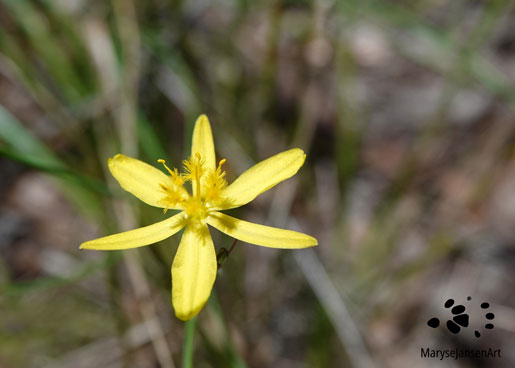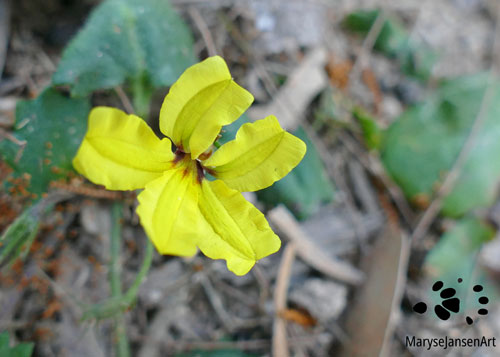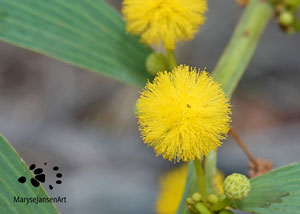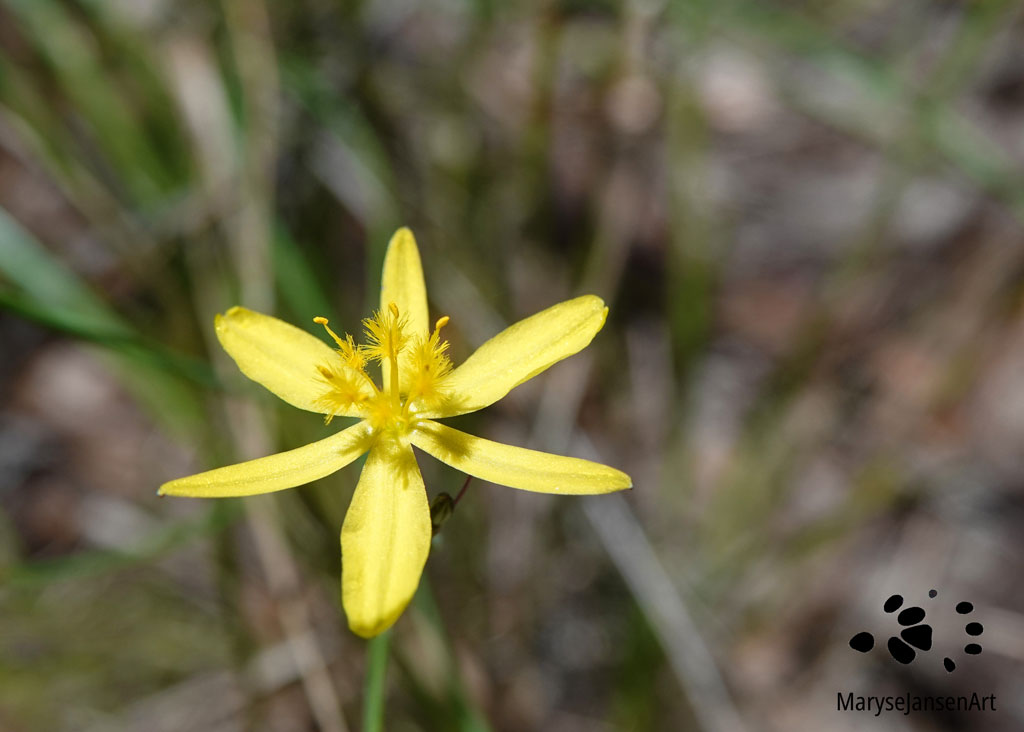Wildflower Photography with marysejansenart
Zooming in on small wildflowers – part 3

Table of Contents
Yellow Rush Lily
Yellow is the dominating colour of the wildflowers in the forest today! At first glance I didn’t notice them in the landscape but upon closer examination the knee high grass on the forest floor is absolutely dotted with tiny yellow flowers!
They belong to the Yellow Rush Lily, also known as Common Rush Lily (Trychorine elatior). This plant gets about 50cm tall and grows in grassy areas, such as here in the undergrowth. The bright yellow flowers are only 20mm wide!
I look even more closely to observe the details of this little flower. The flower gives the impression that it has 6 petals, but actually there are 3 petals and 3 sepals. In flowers like this, where petals en sepals look so alike, they also go by the combined name of tepals! I don’t know if you knew this, but I didn’t! There’s always something to learn!
The stamen, of which there are 6, produce the pollen and have tufts of hair on them. It gives them a bit of a fluffy look, which makes the flower extra pretty.
It’s an Australian native and can be found throughout the country in sclerophyll forests, heaths and woodlands. It likes stony soils in grassy areas and also can be seen in sandy coastal areas. It flowers during spring and summer.
Yellow is the colour of joy and these pretty flowers certainly bring joy to my walk in the forest today.
Broad-leaved Goodenia
Apart from the Yellow Rush Lilies there are other yellow flowers on the forest floor. They are not as abundant but there are quite a few patches of them. These flowers are also quite small but they look a bit bigger because their petals are broader. The 5 yellow petals are fan-shaped and have a dark reddish brown purplish throat. Flowering can occur throughout the year but is most abundant during the summer months.

The plant is a sprawling groundcover amongst grasses and listens to the name Broad-leaved Goodenia or Star Goodenia (Goodenia rotundifolia). It belongs to the Goodeniaceae family. Like the Yellow Rush Lily, this is also an Australian native. It can be found in sclerophyll forests and woodlands in southern Queensland and New South Wales.
It’s a hot summer’s day and the pretty scenery is accompanied by an orchestra of cicadas! It really gives a sense of the forest being alive, buzzing with sound!
Flat-stemmed Wattle
As I bring my gaze up from the forest floor it’s hard to overlook the flowering Wattles. With only 10mm width their cute ball-shaped flowers are even smaller than those Lillies and Goodenias! But they make up for it in density. There are so many fluffy balls on a single branch that it becomes impossible to miss that bright yellow colour!
Wattles (Acacias) belong to the Fabaceae family and they are shrubs or trees. Australia counts over 1000 different species of Acacias! This one here is Acacia Complanata, better known as Flat-stemmed Wattle. It occurs along the east-coast in southern Queensland and northern New South Wales. It’s an understorey shrub in open forests and can reach up to 6 metres in height. It prefers sandy soils and rocky slopes.
The flowers of Wattles are very interesting. They are composite flowers. What we perceive as 1 flower is the little fluffy ball. But actually this ‘flower’ consists of a cluster of lots of tiny little flowers which are also called florets. In Acacia Complanata the cluster contains dozens of florets! You’d really need a magnifying glass to appreciate the detail of one such a little floret!

The Flat-stemmed Wattle mainly flowers from late spring until early autumn but it can produce flowers at other times of the year as well. Most other Wattles do not flower in summer so this one currently gets all the attention. Pale-headed Rosellas like to feed on the seeds. They have been reported edible for humans too, but watch out: not all Wattle seeds are safe to eat. Aboriginal peoples have intricate knowledge of which ones are safe to use as bush tucker and how to prepare them. They have consumed these seeds for their high protein contents for thousands of years. They would be eaten boiled or roasted and ground into flour and baked in the coals of a fire.
Come for a Walk
After these ponderings on Wattle seeds, I walk on. It’s truly a glorious summer day and there is so much to see and hear! It tempts me to create an extra ‘Come for a walk in the Australian Bush’- video this month. I would like to invite you to watch it to experience all the interesting things that cross my path today! Please share in the comments what your favourite sighting was! I’d love to hear from you!
If you are interested in purchasing ‘Yellow Joy’ or would like to see what the image looks like on the various products, please head to my shop.
For other posts in the series ‘Zooming in on small wildflowers’, check out: ‘The Delicate Wombat Berry‘ and ‘5 pretty pea flowers decorating the Australian Bush‘.


